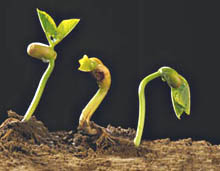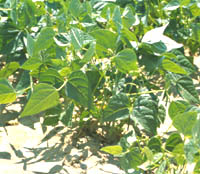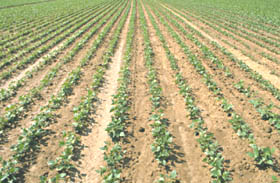
GREN BEANS ON THE FIELD
(from Il Divulgatore)
Place of origin and botanical information
The French bean for the fresh market, Phaseolus vulgaris, belongs to the Leguminoseae family.
It is an annual, determinate plant (vining species are commercially less important), with neuter photoperiodism and very rapid growth.
The light-brown root system is shallow and features a primary root with a great number of lateral roots, where nodules of the Rhizobium legominosarum phaseoli can be found. Living in symbiosis with the bean, this bacterium can fix atmospheric nitrogen and make it available to the plant.
The green stem, which varies in thickness depending on the cultivars, does not need tutors.
Leaves change depending on the development stage. Embryonal leaves are heart-shaped, while later leaves are trifoliate and either heart-shaped or lanceolate, depending on the variety.
Flowers are clustered in racemes and can vary in color from white to pale yellow, the latter color indicating that pod set has occurred.
The fruit, of different shades of green, is made of two valves which enclose seeds and pulp.
As a species of tropical origin, French beans need fairly high temperatures: 18 – 24°C for best growth, 22 – 28°C for seed germination, and 15 – 25°C for pod set. Therefore, low temperatures are disruptive for the plant’s growth: freezing point temperatures cause the plant to die, below 10°C the plant does not grow. On the other hand, temperatures above 35°C also compromise growth and pod set is highly compromised by flower fall. Very windy seasons can also cause damages.

Production
Cycle.
The average production cycle of the fresh market French bean is about 60 - 65 days, although there may be considerable variations depending on seeding time.
For example, in the region Romagna the earliest seedtimes of March and April lead to a cycle of 90 days or more, whereas May and June seedings have a cycle of 55-odd days, and July and August seedings lead to cycles that range from the minimum of days up to some 75 days.
A major factor is obviously temperature: warm seasons reflect in shorter cycles, while cooler spring temperatures reflect in longer production cycles.
Another, less important factor affecting the production cycle is the type of bean. Generally speaking, small- and very small-diameter beans tend to have a 5 to 7 day-longer cycle than medium-diameter beans.
The average production cycle of the fresh market French bean is about 60 - 65 days, although there may be considerable variations depending on seeding time.
For example, in the region Romagna the earliest seedtimes of March and April lead to a cycle of 90 days or more, whereas May and June seedings have a cycle of 55-odd days, and July and August seedings lead to cycles that range from the minimum of days up to some 75 days.
A major factor is obviously temperature: warm seasons reflect in shorter cycles, while cooler spring temperatures reflect in longer production cycles.
Another, less important factor affecting the production cycle is the type of bean. Generally speaking, small- and very small-diameter beans tend to have a 5 to 7 day-longer cycle than medium-diameter beans.


Cultivation
Methods
Beans are considered an “ameliorating” crop, as they do not take big quantities of nutrients away from the soil, thus leaving it “better”, as farmers say, than it was found. This happens thanks to the symbiosis between the bean and the nitrogen-fixing bacterium Rhizobium Leguminosarum. Also, because it is a weeded crop, it helps fight weeds, fungi and bacteria that harm other crops as well. On the other hand, while it does not require particularly difficult growing techniques, its very short cycle during certain periods means that any agronomic action must be very prompt.
Beans are considered an “ameliorating” crop, as they do not take big quantities of nutrients away from the soil, thus leaving it “better”, as farmers say, than it was found. This happens thanks to the symbiosis between the bean and the nitrogen-fixing bacterium Rhizobium Leguminosarum. Also, because it is a weeded crop, it helps fight weeds, fungi and bacteria that harm other crops as well. On the other hand, while it does not require particularly difficult growing techniques, its very short cycle during certain periods means that any agronomic action must be very prompt.